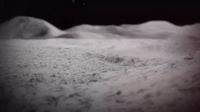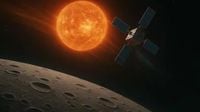A groundbreaking study reveals that water on the Moon’s surface may originate from the solar wind, a finding that could have significant implications for future lunar exploration. Researchers found evidence of water and hydroxyl molecules in lunar regolith, with concentrations ranging from 200 to 300 parts per million. The low deuterium levels in these molecules suggest that their hydrogen is derived from solar particles, highlighting the potential for water resources on other celestial bodies as well.
NASA Confirms Solar Wind’s Role in Lunar Water Formation
For decades, scientists have speculated about the Sun’s contribution to the formation of water on the Moon. This theory, first proposed in the 1960s, posits that water molecules are generated through chemical reactions initiated by solar wind—streams of charged particles emitted by the Sun. Recent experiments led by NASA have validated this hypothesis through the most realistic laboratory simulations to date.
The implications of this discovery are particularly relevant for NASA’s Artemis program, which aims to send astronauts to the Moon’s South Pole. Much of the lunar water is believed to be trapped in permanently shadowed regions, making it a crucial resource for future missions. Understanding the origins of this water could enhance the feasibility of sustained human presence on the Moon.
Mechanics of Water Creation on the Moon
The solar wind, primarily composed of protons—hydrogen nuclei stripped of their electrons—constantly flows from the Sun. While Earth’s magnetic field and atmosphere shield us from most of these particles, the Moon lacks such protection. When protons collide with the lunar surface, which consists of regolith, they interact with electrons, leading to the formation of hydrogen atoms.
Recent findings indicate the presence of both hydroxyl and water molecules beneath the Moon’s surface. These molecules leave a distinctive chemical signature that can be detected through light interaction with the regolith. Currently, scientists categorize “water” as either hydroxyl or water molecules, as distinguishing between the two remains a challenge.
NASA’s research team, including astronaut Yeo, analyzed samples from the Apollo missions using a specialized tool. This particle accelerator simulated solar wind conditions over several days, providing insights into how these processes occur on the Moon.
Broader Implications for Solar System Exploration
The discovery of water on the Moon raises exciting possibilities for other airless bodies in our solar system. If solar wind can create water on the Moon, similar processes may occur on other celestial objects, potentially expanding our understanding of where water exists beyond Earth. This could have profound implications for future space exploration and the search for extraterrestrial life.
As scientists continue to explore the Moon’s resources, the findings from this study will play a vital role in shaping future missions and strategies for sustainable exploration. The presence of water not only supports human activities but also opens new avenues for scientific research and discovery in our quest to understand the universe.
A recent study indicates that water on the lunar surface may come from the solar wind. Water—of most importance as rocket fuel—is present in lunar surface dust, or regolith, produced by meteoroids and charged particles impacting lunar rock. The researchers discovered that several of this graph had evidence of dampness, with between 200 and 300 parts per million of water and the molecule hydroxyl.
The water and hydroxyl in the lunar graph were both low in deuterium, suggesting their hydrogen came from the sun, likely delivered to the moon by solar winds. When the hydrogen particles interact with oxygen present in lunar surface rocks, water molecules arise. The results suggest that other airless bodies in the solar system may also have water on their surfaces, therefore highlighting the possibility of finding such water on the surface of other such objects.
As per the report, it is claimed that scientists have hypothesized—since the 1960s—that the Sun is the source of elements generating water on the Moon. The idea is that water molecules would be produced by a chemical reaction set off by a stream of charged particles—the solar wind—slamming onto the lunar surface. NASA-led researchers have confirmed this prediction in the most realistic lab simulation of this process yet.
Given much of the water on the Moon is believed to be frozen in continuously shadowed areas at the poles, the result affects NASA's Artemis astronaut activities near the South Pole. Constantly flowing from the sun, solar wind is mostly composed of protons—nuclei of hydrogen atoms deprived of their electrons.
Our planet's magnetic shield and atmosphere help most of the solar particles to avoid reaching the surface of Earth. But the Moon has no such protection. As computer models and lab experiments have shown, when protons smash into the Moon's surface, which is made of a dusty and rocky material called regolith, they collide with electrons and recombine to form hydrogen atoms.
Scientists have discovered proof of both hydroxyl and water molecules beneath the moon's surface. These molecules leave a chemical imprint that interacts with light on the regolith. Generally speaking, "water" refers to either one or a mix of both molecules since hydroxyl and water cannot be differentiated right now.
NASA astronaut Yeo and colleagues examined Apollo lunar samples using a customized tool employing two samples worth of dust. Their little particle accelerator battered the dust to create a copy of solar wind spanning many days.
The findings from this study not only shed light on the Moon's resources but also pave the way for future exploration endeavors. As we look to the stars, understanding the origins of water on the Moon could unlock new possibilities for human habitation and scientific discovery throughout the solar system.





